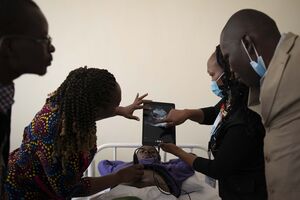
Problem being addressed[edit | edit source]
Uptake and sustainability of many biomedical and medical imaging technologies in low-resource settings has been lacking due to inadequate healthcare provider training and post-implementation support. Globally, 4.7 billion patients lack access to medical ultrasound (RAD-AID). There is less than 1 CT scanner per million inhabitants in low- and middle-income countries (compared to 40 per million in high income countries) and fewer radiologists in West Africa than in the four major teaching hospitals in Boston, Massachusetts (Lancet Oncology Commission Report, The Atlantic).
As an example, antenatal care is an example of critical inequities in global health. In 2020, almost 95% of all maternal deaths occurred in low and lower middle-income countries (WHO). In sub-Saharan Africa, as many as 200,000 mothers and 28 of every 1000 infants die in childbirth every year (UNICEF, WHO). Globally, many critical efforts are underway to improve the quality of antenatal care through investments in clinical training, healthcare infrastructure, and the supply chain. One element of the quality antenatal care puzzle – ultrasound during pregnancy and delivery – is a critical tool for early detection of life-threatening complications.
Detailed description of the solution[edit | edit source]
By providing clinicians with a handheld, cloud-connected ultrasound probe, Butterfly consolidates complex processes into one connected Point-of-Care Ultrasound (POCUS) system to help providers offer better, more efficient patient care.
Today, our solution is being used by many top hospitals across the US and in healthcare delivery settings across the globe. Butterfly iQ+ is the world’s only single-probe, whole-body handheld imaging device, powered by Ultrasound-on-Chip™ technology. This technology, combined with our purpose-built software, integrates with your workflow to remove system barriers, improve efficiencies, and transform patient care. The iQ+ is typically 1/2 to 1/3 the cost of other point-of-care ultrasound systems in the market. The reduced cost is driven by the microchip technology used to create the soundwaves vs. piezoelectric crystals.
Further, the Butterfly Global Health Program seeks to democratize access to medical imaging in vulnerable and marginalized communities across the world by improving access to the Butterfly IQ+ and supporting POCUS implementation and education efforts in resource-constrained settings. Butterfly’s Global Health Program provides accessible pricing for Butterfly products and aids partners in the development of training curricula and user education suitable for their unique needs.
Created by[edit | edit source]
- Created by: Butterfly Network, Inc
Where it is sold[edit | edit source]
The Butterfly IQ+ has regulatory approval and is commercially available in the United States, Canada, and EU as well as 30+ other countries. Butterfly Network, Inc also has a Global Health Program through which global health partners operating in resource-limited settings can procure devices as well as education & implementation support.
Funding Source[edit | edit source]
Butterfly Network, Inc received funding from the Bill and Melinda Gates Foundation for the largest ever distribution and training of POCUS for antenatal care workers in Kenya and South Africa.
References[edit | edit source]
Peer-reviewed publication[edit | edit source]
- Hoffman SA, Desai SN, Sikorski MJ, Fatupaito G, Tupua S, Thomsen RE, Rambocus S, Nimarota-Brown S, Punimata LL, Sialeipata M, Tuilagi CF, Han J, Robins-Browne RM, Naseri TK, Levine MM. Point-of-Care Ultrasound by Nonexpert Operators Demonstrates High Sensitivity and Specificity in Detecting Gallstones: Data from the Samoa Typhoid Fever Control Program. Am J Trop Med Hyg. 2022 Jan 10;106(3):798-804. doi: 10.4269/ajtmh.21-0973. PMID: 35008059; PMCID: PMC8922510.
- Pokaprakarn T, Prieto JC, Price JT, Kasaro MP, Sindano N, Shah HR, Peterson M, Akapelwa MM, Kapilya FM, Sebastião YV, Goodnight W 3rd, Stringer EM, Freeman BL, Montoya LM, Chi BH, Rouse DJ, Cole SR, Vwalika B, Kosorok MR, Stringer JSA. AI Estimation of Gestational Age from Blind Ultrasound Sweeps in Low-Resource Settings. NEJM Evid. 2022 May;1(5):10.1056/evidoa2100058. doi: 10.1056/evidoa2100058. Epub 2022 Mar 28. PMID: 36875289; PMCID: PMC9980216.
- Haldeman MS, Kunka E, Makasa M, Birkland B. Resident perception on the impact of point-of-care ultrasound in clinical care at a family medicine training program in Zambia. Ultrasound J. 2022 May 15;14(1):18. doi: 10.1186/s13089-022-00273-7. PMID: 35569051; PMCID: PMC9107583.
- Marini TJ, Castaneda B, Iyer R, Baran TM, Nemer O, Dozier AM, Parker KJ, Zhao Y, Serratelli W, Matos G, Ali S, Ghobryal B, Visca A, O'Connell A. Breast Ultrasound Volume Sweep Imaging: A New Horizon in Expanding Imaging Access for Breast Cancer Detection. J Ultrasound Med. 2023 Apr;42(4):817-832. doi: 10.1002/jum.16047. Epub 2022 Jul 8. PMID: 35802491.
- Marini TJ, Castaneda B, Parker K, Baran TM, Romero S, Iyer R, Zhao YT, Hah Z, Park MH, Brennan G, Kan J, Meng S, Dozier A, O'Connell A. No sonographer, no radiologist: Assessing accuracy of artificial intelligence on breast ultrasound volume sweep imaging scans. PLOS Digit Health. 2022 Nov 23;1(11):e0000148. doi: 10.1371/journal.pdig.0000148. PMID: 36812553; PMCID: PMC9931251.
Externally generated reports[edit | edit source]
- Bill & Melinda Gates Foundation - AI-Enabled Ultrasound
- AlignMNH 2023 - Transforming Maternal and Neonatal Health through Deployment of Portable Ultrasound at Scale
- Razom Press Release 2023 - BUTTERFLY NETWORK AND RAZOM EXPAND GLOBAL HEALTH PARTNERSHIP TO BRING ADDITIONAL 200 BUTTERFLY IQ+ ULTRASOUND SYSTEMS TO UKRAINE
- Butterfly iQ+ Summary - Pediatric Distal Forearms Fracture Syllabus
Internally generated reports[edit | edit source]
- Butterfly Network, Inc 2023 Impact & Ambition Report